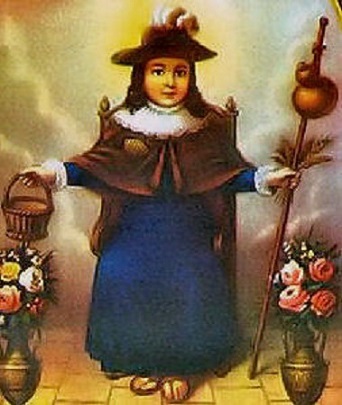Holy Child of Atocha

Birth: Date unknown
Venerated in the Catholic Church
Main: Plateros Sanctuary, Fresnillo
Sanctuary: Zacatecas, Mexico
Celebration: December 25
Portrayed as a small Spanish pilgrim boy, the image of the child Jesus known as Santo Niño de Atocha is dressed in a long gown with a cape that has a wide lace collar and frilled cuffs. The traditional symbol of a pilgrim, a cockleshell, is on his cape, and he holds a little basket in his left hand and a water gourd suspended from a staff in his right hand. The little holy boy wears buckled sandals –huaraches- of silver, and a large, floppy hat with a feather. Although he is known as a wanderer, he is usually shown seated in a little chair.
The Santo Niño de Atocha is a Catholic devotion to the Child Jesus that is very popular in the cultures of Spain, the Philippines, Colombia, Honduras, Venezuela, the southwest of the United States and especially Mexico where it has a Sanctuary in Plateros, community of Fresnillo, Zacatecas; and a church in the city of Tuxtla Gutiérrez, Chiapas.
The original image of the Santo Niño de Atocha found in Plateros represents a child dressed as a pilgrim with a hat, cape, staff with a container for water in the right hand and a basket in the left hand.
It has its apogee or period of maximum splendor During the 13th century, Spain was under the rule of the Muslims. The city of Atocha was invaded by Muslims, who imprisoned the Christians. Christians were seriously punished and had strict prohibitions; The prisoners were denied food because of their beliefs. Finally only children under 12 years of age were allowed to bring them food. The women of Atocha knew that the majority of people in prisons could not survive in those conditions, so they prayed before the image of Our Lady of Atocha, asking her to plead with her son, Jesus Christ, to help them. .
A rumor spread among the people of Atocha that a boy under the age of twelve had begun to bring food to the childless prisoners; the boy was dressed in pilgrim's clothes. The guards who allowed him to feed the prisoners discovered to their surprise that neither the food in the basket nor the water in the boy's jug ran out.
When the women of Atocha heard about the miraculous child, they returned to Our Lady of Atocha, and thanked the Virgin for her intercession. Looking at the image of the Virgin, they realized that the shoes that the Child Jesus was wearing in the hands of Our Lady of Atocha were tattered and full of dust. The shoes were replaced, but they remained dirty. The people of Atocha saw this as a sign that the Baby Jesus came out every night to help those in need.